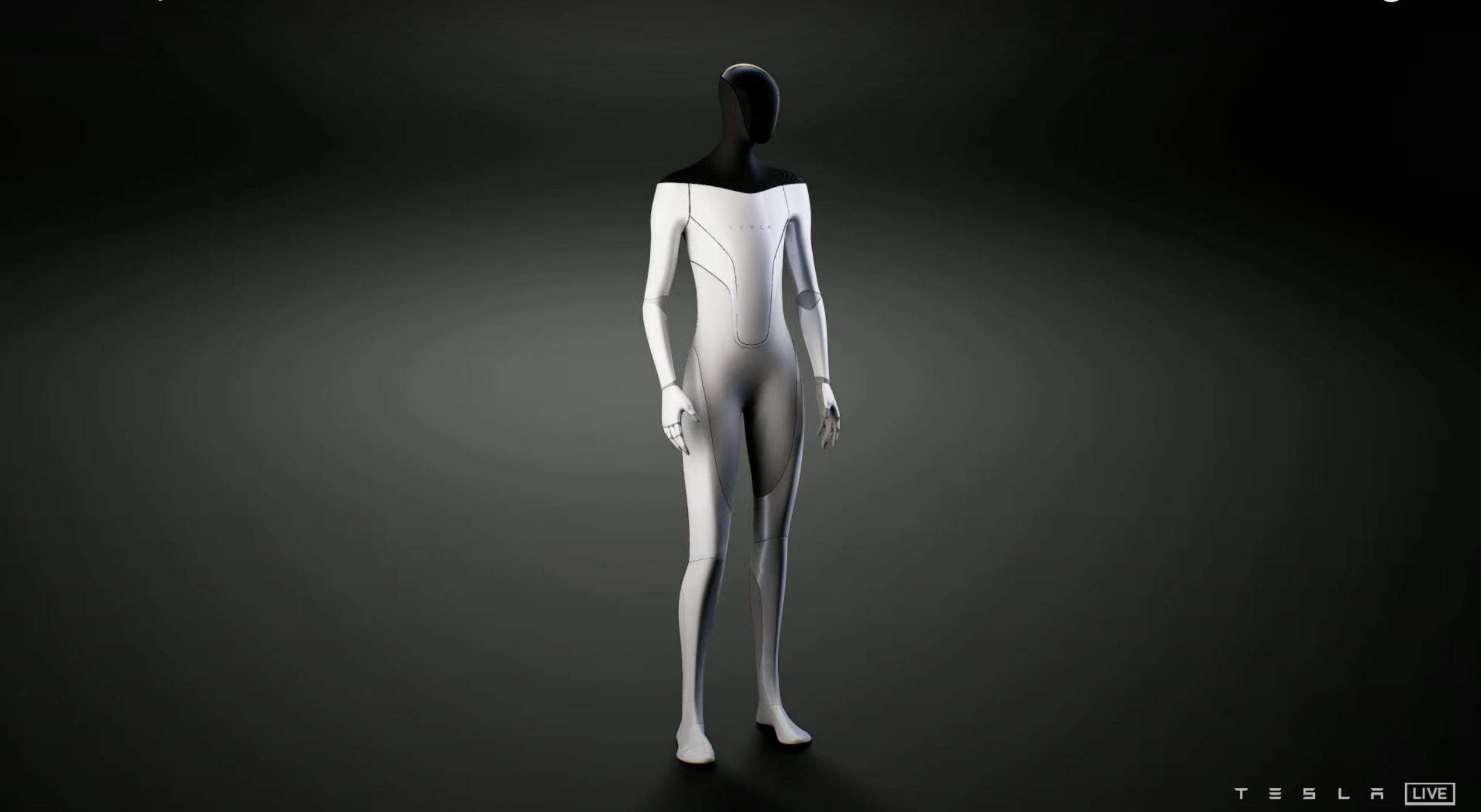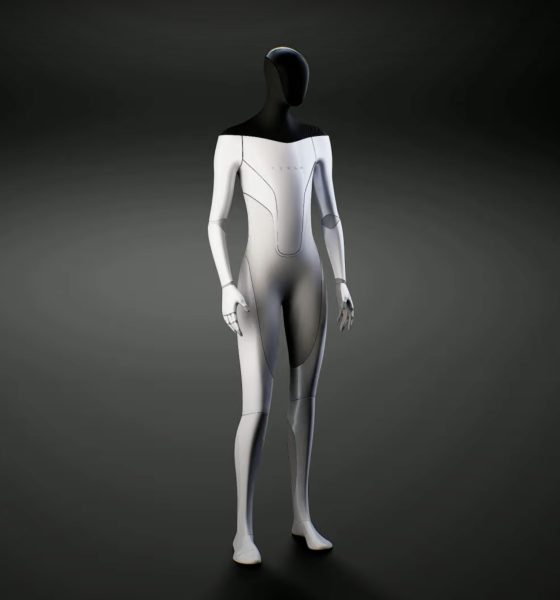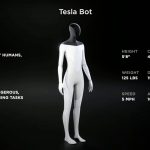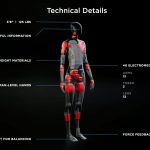Tesla will launch the “Tesla Bot” prototype in 2022, Elon Musk announced during the Artificial Intelligence Event the company held today at its Palo Alto headquarters.
After jokingly walking out a human in the Tesla Bot uniform, Musk said “Tesla Bot will be real.” Musk detailed some of the tasks that the robot will be able to complete, including grocery runs, picking up household objects, and other everyday commands.
The robot will be 5 feet 8 inches tall and 125 pounds. It will include a screen on the face of the bot to display useful information. Additionally, it will have human-level hands. The extremities operate using 40 electromechanical actuators, with two feet, and force feedback sensing for balance and agility. Musk joked that it may be able to run up to 5 MPH.
The Tesla Bot will also utilize some of the company’s AI devices that are operational on the company’s vehicles. Autopilot cameras will essentially act as the vision for the Tesla Bot, while a Full Self-Driving computer will function as the internal organs of the robot, helping it to operate and function as a productive member of the household. It will utilize mutli-camera video neural networks, identical to what was detailed during the company’s AI Event. Additionally, Neural Net planning, labeling, simulation and tools will also be used to help the Tesla Bot operate effectively and efficiently, while accurately performing tasks.
“For this robot, we’re trying to be as literal as possible: Can it do boring, dangerous, repetitive jobs that people don’t want to do. You know, once you have it do that, maybe it can do other things too…I mean, maybe it could be your buddy, too. I’m sure people will think of some very creative uses,” Musk joked.
The Tesla Bot won’t be available until next year, Musk said, especially as the robot will utilize the Dojo Supercomputer’s training mechanisms to improve functionality. It seems that Tesla’s idea for the robot is to decrease the need to perform tasks by yourself. There will be “no shortage of labor,” Musk said about the future, but physical work will simply be a choice. The Tesla Bot’s purpose could eliminate the need to perform minimal, mindless tasks around the house. “For the Tesla bot it’s going to start with work that is boring and repetitive Basically work that a person would least like to do,” Musk added.
“Things that I think are very hard about having a useful humanoid robot is ‘Can it navigate through the world without being explicitly trained?’ Without explicit line-by-line instructions,” Musk said. “Can you talk to it and say ‘Pick up that bolt, attach it to the car with that wrench. It should be able to do that.”
The development of the robot seems to be a responsibility of Musk’s, especially as the CEO has been critical of AI’s potential power in the past. On an episode of the Joe Rogan Experience podcast, Musk once warned that AI could become increasingly dangerous if overdeveloped, especially as its mind and memory are terrifically powerful.
Don’t expect to see the Robot on Tesla’s production lines, either. Musk said the parts were there, and Tesla decided to make it. “If we don’t, someone else would, so I guess we should probably make it. And make it safe,” Musk said.
Don’t hesitate to contact us with tips! Email us at tips@teslarati.com, or you can email me directly at joey@teslarati.com.

News
Tesla FSD fleet is nearing 7 billion total miles, including 2.5 billion city miles
As can be seen on Tesla’s official FSD webpage, vehicles equipped with the system have now navigated over 6.99 billion miles.

Tesla’s Full Self-Driving (Supervised) fleet is closing in on almost 7 billion total miles driven, as per data posted by the company on its official FSD webpage.
These figures hint at the massive scale of data fueling Tesla’s rapid FSD improvements, which have been quite notable as of late.
FSD mileage milestones
As can be seen on Tesla’s official FSD webpage, vehicles equipped with the system have now navigated over 6.99 billion miles. Tesla owner and avid FSD tester Whole Mars Catalog also shared a screenshot indicating that from the nearly 7 billion miles traveled by the FSD fleet, more than 2.5 billion miles were driven inside cities.
City miles are particularly valuable for complex urban scenarios like unprotected turns, pedestrian interactions, and traffic lights. This is also the difference-maker for FSD, as only complex solutions, such as Waymo’s self-driving taxis, operate similarly on inner-city streets. And even then, incidents such as the San Francisco blackouts have proven challenging for sensor-rich vehicles like Waymos.
Tesla’s data edge
Tesla has a number of advantages in the autonomous vehicle sector, one of which is the size of its fleet and the number of vehicles training FSD on real-world roads. Tesla’s nearly 7 billion FSD miles then allow the company to roll out updates that make its vehicles behave like they are being driven by experienced drivers, even if they are operating on their own.
So notable are Tesla’s improvements to FSD that NVIDIA Director of Robotics Jim Fan, after experiencing FSD v14, noted that the system is the first AI that passes what he described as a “Physical Turing Test.”
“Despite knowing exactly how robot learning works, I still find it magical watching the steering wheel turn by itself. First it feels surreal, next it becomes routine. Then, like the smartphone, taking it away actively hurts. This is how humanity gets rewired and glued to god-like technologies,” Fan wrote in a post on X.
News
Tesla starts showing how FSD will change lives in Europe
Local officials tested the system on narrow country roads and were impressed by FSD’s smooth, human-like driving, with some calling the service a game-changer for everyday life in areas that are far from urban centers.

Tesla has launched Europe’s first public shuttle service using Full Self-Driving (Supervised) in the rural Eifelkreis Bitburg-Prüm region of Germany, demonstrating how the technology can restore independence and mobility for people who struggle with limited transport options.
Local officials tested the system on narrow country roads and were impressed by FSD’s smooth, human-like driving, with some calling the service a game-changer for everyday life in areas that are far from urban centers.
Officials see real impact on rural residents
Arzfeld Mayor Johannes Kuhl and District Administrator Andreas Kruppert personally tested the Tesla shuttle service. This allowed them to see just how well FSD navigated winding lanes and rural roads confidently. Kruppert said, “Autonomous driving sounds like science fiction to many, but we simply see here that it works totally well in rural regions too.” Kuhl, for his part, also noted that FSD “feels like a very experienced driver.”
The pilot complements the area’s “Citizen Bus” program, which provides on-demand rides for elderly residents who can no longer drive themselves. Tesla Europe shared a video of a demonstration of the service, highlighting how FSD gives people their freedom back, even in places where public transport is not as prevalent.
What the Ministry for Economic Affairs and Transport says
Rhineland-Palatinate’s Minister Daniela Schmitt supported the project, praising the collaboration that made this “first of its kind in Europe” possible. As per the ministry, the rural rollout for the service shows FSD’s potential beyond major cities, and it delivers tangible benefits like grocery runs, doctor visits, and social connections for isolated residents.
“Reliable and flexible mobility is especially vital in rural areas. With the launch of a shuttle service using self-driving vehicles (FSD supervised) by Tesla in the Eifelkreis Bitburg-Prüm, an innovative pilot project is now getting underway that complements local community bus services. It is the first project of its kind in Europe.
“The result is a real gain for rural mobility: greater accessibility, more flexibility and tangible benefits for everyday life. A strong signal for innovation, cooperation and future-oriented mobility beyond urban centers,” the ministry wrote in a LinkedIn post.
News
Tesla China quietly posts Robotaxi-related job listing
Tesla China is currently seeking a Low Voltage Electrical Engineer to work on circuit board design for the company’s autonomous vehicles.

Tesla has posted a new job listing in Shanghai explicitly tied to its Robotaxi program, fueling speculation that the company is preparing to launch its dedicated autonomous ride-hailing service in China.
As noted in the listing, Tesla China is currently seeking a Low Voltage Electrical Engineer to work on circuit board design for the company’s autonomous vehicles.
Robotaxi-specific role
The listing, which was shared on social media platform X by industry watcher @tslaming, suggested that Tesla China is looking to fill the role urgently. The job listing itself specifically mentions that the person hired for the role will be working on the Low Voltage Hardware team, which would design the circuit boards that would serve as the nervous system of the Robotaxi.
Key tasks for the role, as indicated in the job listing, include collaboration with PCB layout, firmware, mechanical, program management, and validation teams, among other responsibilities. The role is based in Shanghai.
China Robotaxi launch
China represents a massive potential market for robotaxis, with its dense urban centers and supportive policies in select cities. Tesla has limited permission to roll out FSD in the country, though despite this, its vehicles have been hailed as among the best in the market when it comes to autonomous features. So far, at least, it appears that China supports Tesla’s FSD and Robotaxi rollout.
This was hinted at in November, when Tesla brought the Cybercab to the 8th China International Import Expo (CIIE) in Shanghai, marking the first time that the autonomous two-seater was brought to the Asia-Pacific region. The vehicle, despite not having a release date in China, received a significant amount of interest among the event’s attendees.












